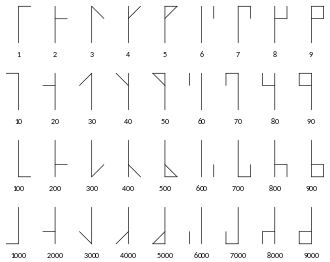The Ciphers of the Monks
The Ciphers of the Monks: A Forgotten Number-notation of the Middle Ages is a book by David A. King.
Content
The book describes in detail a numeral system that was commonly used by European monks in the Middle Ages. That number system allowed one to write numbers from 1 to 9999 with minimum of strokes. This numeral system later fell out of use.[1]
The cipher


The system uses a vertical straight line as its main symbol. This symbol is essentially an axis that divides the two-dimensional plane into four quadrants. Each of these four quadrants signifies one of the four digits. The number can then be determined by visual inspection.[2][3]
The numeral system was invented in the 1300s by French Cistercian monks. It was later replaced by the Hindu–Arabic numeral system. In any case, this numeral system later inspired several shorthands and secret ciphers.
In Britain, the first person to use this cipher was John of Basingstoke.
Reviews
The book has generally received positive reviews.[4][5][6][7]
References
- "~jensh/publications/2002%7BR%7D21_King_Ciphers" (PDF). akira.ruc.dk. Retrieved 2015-08-13.
- Gianni A. Sarcone. "Numbers' history". archimedes-lab.org. Retrieved 2015-08-13.
- "Notae Elegantissimae | Baliem Shares Anything". baliems.wordpress.com. Retrieved 2015-08-13.
- book review on Amazon
- King, D.A. (2001). The Ciphers of the Monks: A Forgotten Number-notation of the Middle Ages. F. Steiner. ISBN 9783515076401. Retrieved 2015-08-13.
- "book review in Speculum, Vol. 78, No. 3, July 2003". JSTOR 20060835. Cite journal requires
|journal=(help) - book review on ____ Archived 2013-10-19 at Archive.today
External links
- "David A. King". davidaking.org. Retrieved 2015-08-13.
- The ciphers of the monks (Open Library). openlibrary.org. OL 19028209M.
- David A. King (2001). The Ciphers of the Monks: A Forgotten Number-notation of the Middle Ages. F. Steiner. p. 171. ISBN 9783515076401. Retrieved 2015-08-13.